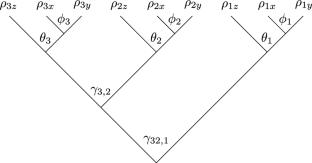n体问题中的经典大角动量
IF 1.8
4区 物理与天体物理
Q2 PHYSICS, MULTIDISCIPLINARY
引用次数: 0
摘要
大角动量的概念在量子力学研究n体问题中得到了广泛的应用。这里,我们将其应用于n体问题的经典分析。利用雅可比坐标和超球坐标的树表示,我们发现了它的大小在三维中分解为一个物体角动量的大小。推广了两体情况下的一些结果,导出了n体散射角的一般表达式。本文章由计算机程序翻译,如有差异,请以英文原文为准。

Classical Grand Angular Momentum in N-Body Problems
The concept of grand angular momentum is widely used in the study of N-body problems quantum mechanically. Here, we applied it to a classical analysis of N-body problems. Utilizing the tree representation for Jacobi and hyperspherical coordinates, we found a decomposition of its magnitude into magnitudes of one-body angular momenta in three dimensions. We generalized some results from the two-body case and derived a general expression for the scattering angle in N-body problems.
求助全文
通过发布文献求助,成功后即可免费获取论文全文。
去求助
来源期刊

Few-Body Systems
物理-物理:综合
CiteScore
2.90
自引率
18.80%
发文量
64
审稿时长
6-12 weeks
期刊介绍:
The journal Few-Body Systems presents original research work – experimental, theoretical and computational – investigating the behavior of any classical or quantum system consisting of a small number of well-defined constituent structures. The focus is on the research methods, properties, and results characteristic of few-body systems. Examples of few-body systems range from few-quark states, light nuclear and hadronic systems; few-electron atomic systems and small molecules; and specific systems in condensed matter and surface physics (such as quantum dots and highly correlated trapped systems), up to and including large-scale celestial structures.
Systems for which an equivalent one-body description is available or can be designed, and large systems for which specific many-body methods are needed are outside the scope of the journal.
The journal is devoted to the publication of all aspects of few-body systems research and applications. While concentrating on few-body systems well-suited to rigorous solutions, the journal also encourages interdisciplinary contributions that foster common approaches and insights, introduce and benchmark the use of novel tools (e.g. machine learning) and develop relevant applications (e.g. few-body aspects in quantum technologies).
 求助内容:
求助内容: 应助结果提醒方式:
应助结果提醒方式:


